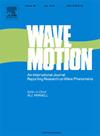Novel solitary patterns in a class of regularized Gardner equations
IF 2.5
3区 物理与天体物理
Q2 ACOUSTICS
引用次数: 0
Abstract
We introduce and study a class of equations that merge the Gardner’s-type, non-convex, advection with regularized long-wave dispersion, also known as Benjamin–Bona–Mahony equation, to the effect that unlike the unidirectional Gardner solitons, the presented model supports bidirectional propagation of at least three types of solitary waves and begets a whole gallery of chase and collision interactions. Among the novel features of our model, we mention the possibility that one of the solitons reverses its direction upon interaction with another soliton. Extension of the model to higher dimensions typically causes the newly found solitary waves to split into a countable sequence of multi-modal solitary waves wherein either mode’s amplitude increases with its modality, or the modes condense near their potential’s top.
一类正则Gardner方程中的新孤立模式
我们引入并研究了一类将加德纳型非凸平流与正则长波色散(也称为benjaminbona - mahony方程)合并在一起的方程,其效果与单向加德纳孤子不同,所提出的模型支持至少三种类型的孤立波的双向传播,并产生一整套追逐和碰撞相互作用。在我们模型的新特征中,我们提到了其中一个孤子在与另一个孤子相互作用时改变方向的可能性。将模型扩展到更高的维度通常会导致新发现的孤立波分裂成多模态孤立波的可数序列,其中任一模态的振幅随其模态而增加,或者模态在其势的顶部附近凝聚。
本文章由计算机程序翻译,如有差异,请以英文原文为准。
求助全文
约1分钟内获得全文
求助全文
来源期刊

Wave Motion
物理-力学
CiteScore
4.10
自引率
8.30%
发文量
118
审稿时长
3 months
期刊介绍:
Wave Motion is devoted to the cross fertilization of ideas, and to stimulating interaction between workers in various research areas in which wave propagation phenomena play a dominant role. The description and analysis of wave propagation phenomena provides a unifying thread connecting diverse areas of engineering and the physical sciences such as acoustics, optics, geophysics, seismology, electromagnetic theory, solid and fluid mechanics.
The journal publishes papers on analytical, numerical and experimental methods. Papers that address fundamentally new topics in wave phenomena or develop wave propagation methods for solving direct and inverse problems are of interest to the journal.
 求助内容:
求助内容: 应助结果提醒方式:
应助结果提醒方式:


